| |
|
|
34.
| Civilization |
| |

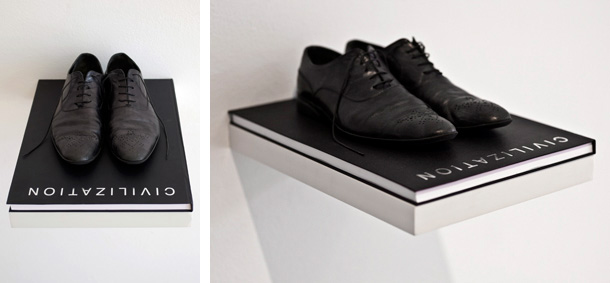
2013, 30 x 43 cm, the artist's shoes, book.
Exhibition view from Darkening Process, MMP+, 2016, Marrakech.
Courtesy of the artist and Ceysson & Bénétière, Paris.
Ed. of 5 + 1 A.P.
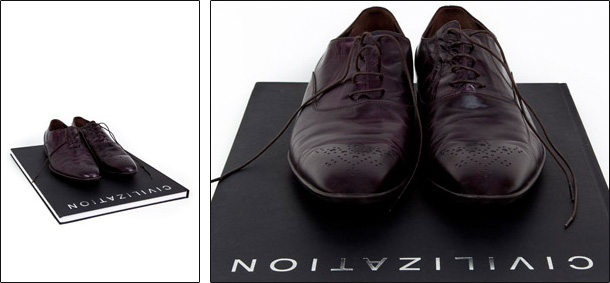
2013-2014, 30 x 43 cm, the artist's shoes, book.
Exhibition view from Art of War, ADN Platform, 2014, Sant Cugat del Vallès.
Courtesy of the artist and ADN gallery, Barcelona.
Ed. of 5 + 1 A.P.
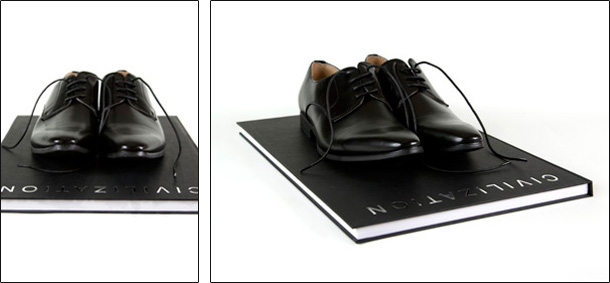
2013-2014, 30 x 43 cm, the artist's shoes, book.
Exhibition view from Transition State, Officine Dell'Immagine, 2017, Milano
Courtesy of the artist and Ceysson & Bénétière, Paris.
Ed. of 5 + 1 A.P.
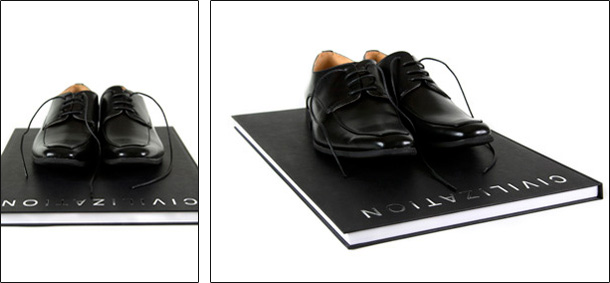
2013-2014, 30 x 43 cm, the artist's shoes, book.
Exhibition view from Le Voyage de Claude Lévi-Strauss, Institut Français, 2013, Casablanca.
Courtesy of the artist and Ceysson & Benetiere, Paris
Ed. of 5 + 1 A.P.
'' The esthetic appeal of Civilization is reminiscent of both a shop window and a beautiful carnivorous plant:
its seduction is a trap that will close in on the viewer who gets too close. ''
Studio Fatmi, April 2017
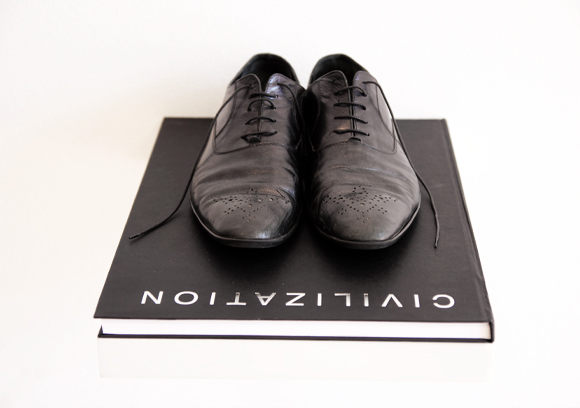
Civilization
Exhibition view from Darkening Process, MMP+, 2016, Marrakech
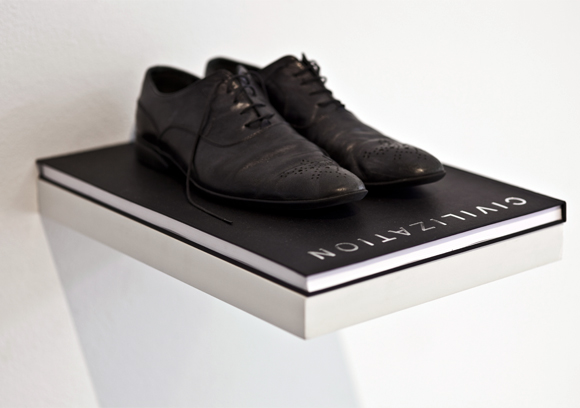
Civilization
Exhibition view from Darkening Process, MMP+, 2016, Marrakech
|
|
|
|
|
|
Civilisation attire le spectateur en exerçant sur lui une séduction comparable à celle d'une vitrine de chausseur de luxe. Une paire de chaussures noires en cuir lustré repose sur un livre de grand format lui-même juché sur un présentoir blanc immaculé. La couverture de l'ouvrage, en vélin de couleur noire, laisse apparaître son titre, inscrit en anglais et en lettres majuscules à l'élégante typographie argentée : "CIVILIZATION".
"The Beautiful Language" et "Le Tableau noir", œuvres également réalisées en 2013, s'attachent à mettre en évidence la violence de l’apprentissage et de l'assimilation des savoirs et des langages et proposent une stratégie à tenir face à ces processus. Civilisation interroge de manière très large l'acquisition des comportements sociaux, en présentant deux objets qui sont parfois présentés comme des indicateurs ou des révélateurs du degré de civilisation d'un peuple : la chaussure et le livre.
Civilisation fait se rencontrer des objets manufacturés, produits en masse en se contentant de les juxtaposer - ou plus exactement ici, de les superposer. Le public est ainsi convié à explorer la polysémie du terme "civilisation" : à la fois ensemble des conditions matérielles et culturelles propre à un peuple, et processus exercé par une culture dominante sur une autre et qui prétend en perfectionner les conditions d'existence. Le spectateur est appelé à découvrir que la séduction exercée par ces objets de culture et de consommation masque une forme de violence et de brutalité. La mise en scène de la chaussure par Mounir Fatmi renvoie en effet à une autre scène, extraite de L'Enfant sauvage de Truffaut (film auquel font aussi référence "Le Tableau noir" et "The Beautiful Language"), où le docteur oblige le garçon à porter des chaussures pour la première fois de son existence, ce qui conduit ce dernier à une crise nerveuse.
L'attrait esthétique de Civilisation relève finalement à la fois de la vitrine du marchand et de la belle plante carnivore : sa séduction est un piège qui se referme sur le spectateur qui s'en approche. Et cependant, dans le même temps et de façon assez paradoxale, Civilisation se veut mise en garde contre cette séduction. L'œuvre délivre une leçon sur la juste distance qu'il faut maintenir avec les "éléments de civilisation". Elle constitue ainsi une forme particulière de ready-made dans la mesure où, s'elle prive les objets présentés de leur fonction utilitaire et par la même annule leur pouvoir et leur menace éventuelle, elle participe à une stratégie où l'artiste fait jouer un pouvoir contre un autre - les chaussures maintenant en quelque sorte le livre fermé. Un détail est à relever enfin, qu'on n'observe jamais sur un présentoir de magasin : les lacets des chaussures exposées sont défaits. Détail qui se glisse comme une image subliminale dans l'esprit du spectateur et qui suggère peut-être que l'artiste a pour sa part refermé le livre, enlevé ses chaussures, et ressuscité l'enfant sauvage…
Studio Fatmi, Avril 2017.
|
|
Civilization entices the viewer through seductive qualities comparable to those of the window display in a luxury shoe shop. A pair of black leather shoes rests upon a large book, which is itself set upon an immaculate white display stand. The cover of the book, made of black vellum, shows its title, written in English, in capital letters with an elegant silver font: “CIVILIZATION”.
“The Beautiful Language” and “The Blackboard”, also created in 2013, are two works that also attempt to show the violence of learning and assimilating knowledge and languages, and to propose a strategy to confront these processes. Civilization questions in a very broad way the acquisition of social behaviors by showcasing two objects that are sometimes presented as indicators or revelators of the level of civilization of a people: a shoe and a book.
Civilization brings together mass-produced manufactured objects, simply juxtaposing them – or rather here, superimposing them. The viewer is invited to explore the polysemy of the term “civilization”: a set of material and cultural conditions specific to a people, but also a process imposed by a dominant culture on another, claiming to improve its living conditions. The viewer is invited to discover that the seduction exercised by these objects of culture and consumption hides a form of violence and brutality. The staging of the shoe by Mounir Fatmi brings to mind a scene from François Truffaut’s film “The Wild Child” (“The Blackboard” and “The Beautiful Language” also reference this movie), where the doctor forces the boy to wear shoes for the first time in his life, triggering a nervous crisis.
The esthetic appeal of Civilization is reminiscent of both a shop window and a beautiful carnivorous plant: its seduction is a trap that will close in on the viewer who gets too close. But at the same time, Civilization paradoxically can also be seen as a warning message against this seduction. The piece delivers a lesson on the right distance to maintain with the “elements of civilization”. It constitutes a particular form of ready-made in the sense that it strips the presented objects of their functionality, and in doing so, annihilates their power and potential menace. This is part of a strategy in which the artist counterbalances one form of power with another – the shoe essentially keeping the book shut. One detail bears mentioning, something that is never seen in shop displays: the laces of the presented shoes are undone. This detail surreptitiously enters the mind of the viewer like a subliminal image and perhaps suggests that the artist himself closed the book, took off his shoes and revived the wild child…
Studio Fatmi, April 2017.
|
|
|
|